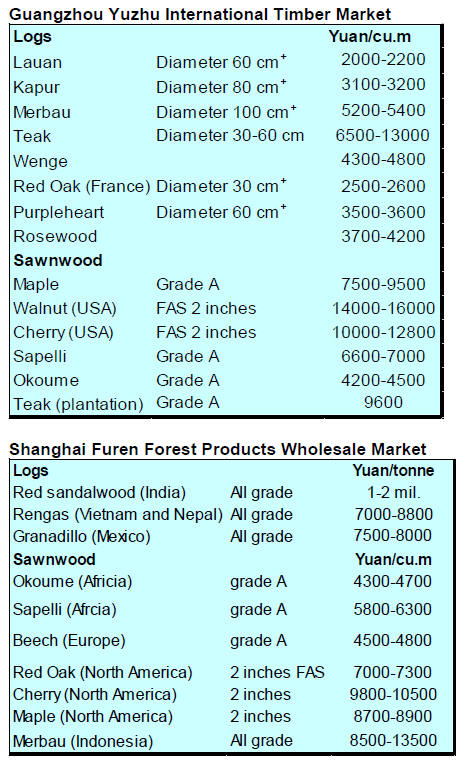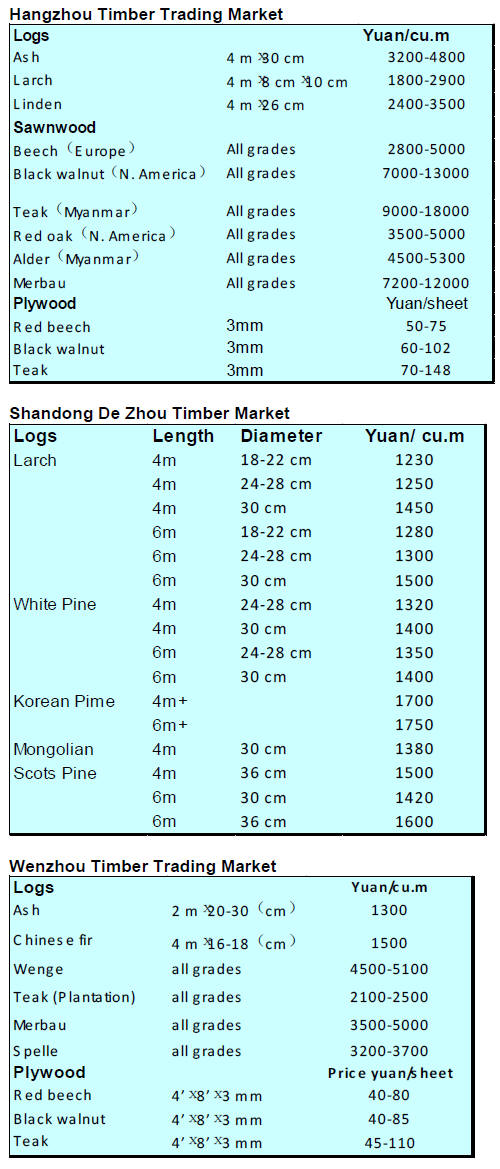US Dollar Exchange Rates of 12th
June 2013
China Yuan 6.1350
Report from China
Slide in industrial output continued in May
In May China¡¯s Producer Price Index (PPI) for manufactured goods fell
2.9 percent year-on-year and declined 0.6 percent month-on-month.
The purchasing price index for manufactured goods went down by 3.0
percent year-on-year, and 0.6 percent month-on-month.
On average, in the first five months of 2013, the PPI dropped 2.1
percent, year-on-year while the index for manufactured goods went down
by 2.3 percent year-on-year.
Weakness in the Chinese economy can be still detected as industrial
output continues to slow. According to the National Bureau of Statistics
industrial production in May came in at 9.2%, almost at the same level
as in May twelve months ago.

The National Bureau of Statistics also revealed that in May, the consumer
price index (CPI) went up by 2.1 percent year-on-year.
Prices grew by 2.1 percent in cities and 2.2 percent in rural areas;
food prices went up by 3.2 percent, while the non-food prices increased
by 1.6 percent.
The prices of consumer goods went up by 1.8 percent and the prices of
services grew by 2.8 percent.
On average, from January to May, overall consumer prices were up by 2.4
percent over the same period last year.
Loan default risks rise in Yangtze River Delta companies
China's central bank, the People's Bank of China (PBOC), has said in a
press release that the bad loan balance had increased for the first time
in over 5 years and has warned of rising financial risks in a range of
sectors.
The balance of defaulted loans for commercial banks was 528.1 billion
yuan, surging 46 percent from the beginning of the year. Defaulting
risks are mainly found in the Yangtze River Delta where the market
economy and small enterprises prosper.
Overcapacity in some sectors such as solar panel manufacturing, iron and
steel making and cement very vulnerable says the Bank.
Growth forecast cut by IMF and OECD
Economic growth in China slipped to 7.7 percent in the first
quarter, down from 7.9 percent in the previous quarter. Both the
International Monetary Fund and the Organization for Economic
Co-operation and Development cut their forecasts for China's economic
2013 economic growth in May, to 7.75 percent and 7.8 percent,
respectively
Both agencies say that China's economic growth will likely decline
further in the second quarter. These forecasts come after May export
growth fell to the lowest in twelve months. May exports to China¡¯s main
markets, the US and EU, fell for the third consecutive month.
Direct convertibility of yuan brings benefits and risks
Currently, the Chinese yuan is directly convertible with the
Japanese yen and the Australian dollar and there are reports that China
and New Zealand are in negotiations for direct convertibility.
Direct convertibility cuts the costs of transactions and lowres the
risks from too tight a tie to the US dollar, but direct convertibility
can also bring some risks to exporters.
It is now twelve months since the yen and yuan became directly
convertible and in this time the yuan has gained some 20 percent against
the yen greatly affecting trade between China and Japan.
Exporting furniture costs more because of EUTR
The value of furniture exports from Chongqing City rose sharply in
2012 to US$2.18 billion and the main markets were the member states of
the EU, the US and Southeast Asian countries.
Buyers in the EU now require evidence on the source and legality of raw
materials used in the manufacture of furniture so exporters have to
provide a range of documents.
Meeting the requirements of the EUTR has increased the cost of exports
to the EU and furniture companies in Chongqing City say costs have
increased by as much as 5 percent which is undermining their
competitiveness.
30 percent of domestic timber product sales from manufacturers in
Wenzhou City
The 2013 Conference of China¡¯s Chamber of Commerce for import and export
of timber was held in Wenzhou City recently.
According to information from the recently concluded conference in
Wenzhou City, around 30% of the domestic market for wood products is met
from manufacturers in Wenzhou.
The Wenzhou Timber Group Co., Ltd, one of China's leading timber
importers, has been engaged in the timber trade for 25 years and imports
timber from Africa, Papua New Guinea and Solomon Islands.
The distribution centre for the Wenzhou Timber Group is in Zhangjiagang
Port and imported timber goes directly to domestic manufacturers. The
Group still uses traditional sales outlets but intends to soon establish
an electronic trading platform.
Furniture makers in Dalian City say export orders down 30 percent
There are more than 100 large size furniture enterprises with an output
value of more than RMB5 million in Dalian City but, as is the case for
other manufacturers, the furniture industry is facing severe challenges
and the level of export orders is down around 30 percent.
According to Mr. Ma Xiaoling, Deputy Secretary General of Dalian
Furniture Association, the pace of growth in orders from overseas has
slowed and this, along with the appreciation of the renminbi, is
undermining the profitability of Dalian furniture enterprises.
Because of weak domestic demand and price factors foreign customers are
gradually shifting purchases from China to low cost producers in
Vietnam, Indonesia and Southeast Asian countries which adds to the
problems of Dalian furniture exporters.
Timber trade between China and Canada strengthened
A timber trade delegation from China recently visited Canada. The
delegation included representatives from China Timber and Wood Products
Distribution Association and the Ministry of Commerce.
The government of British Columbia (BC) imposed rules on the trade in
logs and these have been seen as a form of export restriction.
The BC regulation requires that all logs from the province must be first
offered to BC consumers at domestic prices and that only if not
purchased locally can they be exported.
In addition, the Canadian government has imposed a levy on exported logs
which has affected trade with China. As a result of the Canadian
regulations many Chinese timber importers have switched to buying from
New Zealand, Sweden, Australia and Chile.
The Chinese timber delegation put forward several suggestions which
could lead to a resumption of unrestricted trade between the two
countries.
China-ASEAN Forest Wood Products Expo will be held in Guangxi
The 2013 China - ASEAN Forest Products and Wood Products Expo will be
held at the international convention and exhibition centre in Nanning
City, Guangxi Zhuang Autonomous Region from November 15-18. Exhibition
pavilions will be set up for wood products, wooden furniture, mahogany
furniture, woodworking machinery as well as flowers and seedlings.
The China - ASEAN Expo has been held ten times and attracted over 1,300
participating enterprises and a total of about 60,000 visitors. Reports
indicate that business concluded in 2011 reached RMB650 million.
Much of China¡¯s output of wood products and wood working machinery is
exported to ASEAN countries. Some Chinese products are also re-exported
through ASEAN countries.
In recent years investment by Chinese enterprises in ASEAN has grown and
Chinese companies such as Power Dekor and Nature and Elegant Living have
opened stores in ASEAN countries.
Analysts report that much of the wood processing machinery for sawmills
and wood-based panel industries in Vietnam have been supplied by Chinese
enterprises.
In addition to supplying processing equipment, more than 30 Chinese
enterprises have established wood processing plants in ASEAN countries.
The China-ASEAN Forest Wood Products Expo is a regional and
international timber industry event which has now built an effective
interactive platform for trade and investment cooperation between China
and ASEAN countries.


¡¡
|